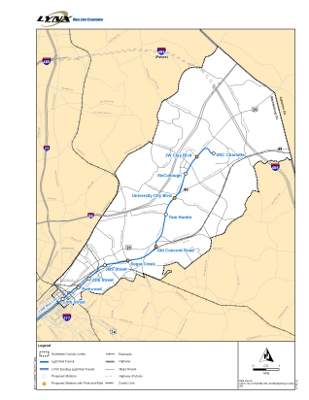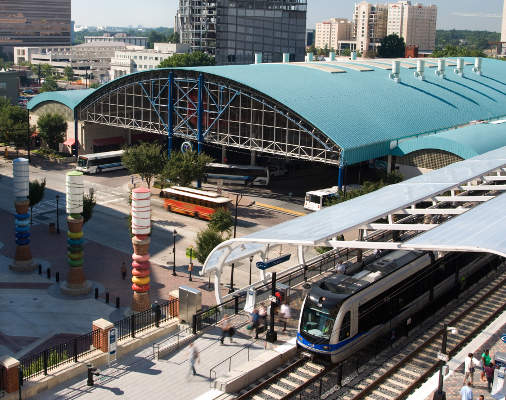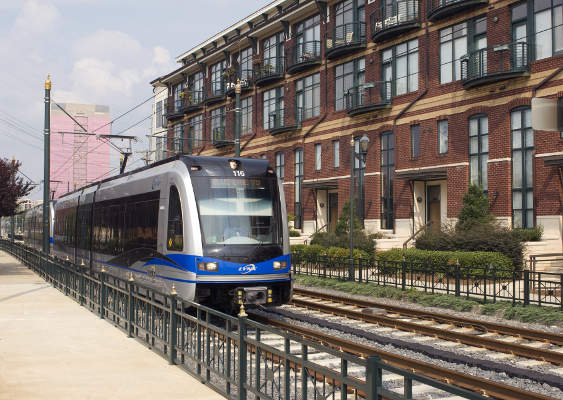The LYNX Blue Line Extension (BLE) is a 9.3-mile (14.9km) light rail project that extended the LYNX Blue Line operated by the Charlotte Area Transit System (CATS) in Charlotte, North Carolina, US.
The light rail extension serves the north-east corridor, spanning from the city centre to the University of North Carolina (UNC).
The expansion was designed for present and future transport needs in the corridor and offers a suitable alternative to automobile travel. It also provides improved transit services to the UNC, as well as major activity centres in the region, while reducing traffic congestion.
The LYNX Blue Line Extension project involved an investment of $1.16bn. Construction of the light rail project started in late 2013 and the extension was opened to public in March 2018.
North Carolina’s first rapid transit line
LYNX Blue Line is the first rapid transit line in North Carolina and was opened for service in November 2007. It is a 9.6-mile light rail line running from uptown on 7th Street in the city centre to the south end of the city on South Boulevard, near Interstate 485.
The previous Blue Line had 15 stations and was operated by a fleet of 20 light rail vehicles. The average daily ridership was initially 8,700 passengers, but has increased to 15,900 passengers.
History of the light rail extension project
The Blue Line Extension project was first proposed by CATS in 2002. The US Federal Transit Administration (FTA) approved the preliminary engineering of the project in November 2007. The final environmental impact statement of the project was submitted towards the end of 2011.
In December 2011, the record of decision on the project was signed and issued by the FTA. The project’s entry into final design was approved in July 2012. In October 2012, the project received the Federal Full Funding Grant Agreement (FFGA).
CATS LYNX Blue Line Extension details
The LYNX Blue Line Extension (north-east corridor) extends from the border of downtown Charlotte on Ninth Street in the city centre to the UNC Charlotte campus. The 9.3-mile (14.9km) light rail line passes through the North Davidson (NoDa) Arts District and University areas.
Approximately three miles of the new light rail line running between the first five stations from the city centre and NoDa is operated on a separate track in North Carolina Railroad Company’s (NCRR) existing corridor. The remaining length is operated along North Tryon Street (US 29).
CATS signed lease, construction and operating agreements with NCRR and Norfolk Southern Corporation for the extension along the rail road corridor. The extension includes 11 stations and four parking facilities. All of the service’s stations have canopy coverage and covered ticket vending machines. Most of the stations have access to the CATS bus network.
The extension offers a two-way improved connection between UNC Charlotte campus and the city centre in addition to improved transit services. It reduces 20-mile cross-county travel time to 47 minutes.
The LYNX BLE will enable passengers to cover the distance between the UNC Charlotte campus and Center City in nearly 25 minutes. Additional capacity of three-car trains is expected to increase ridership to more than 25,000 passengers a day.
Funding and rolling stock
The FTA funded 50% of the project cost and the State Full Funding Grant Agreement financed 25% of the project cost. The remaining 25% was met through other sources, including 1/2 Cent Sales Tax and north-east corridor infrastructure funds.
The line initially operated with 16 S70 Avanto vehicles, supplied by Siemens under a $52m contract placed in 2004. In 2010, Siemens delivered four additional Avanto vehicles as part of an order signed in 2008.
The maximum passenger capacity of each car is 236 with a seating capacity of 68. The maximum speed of each vehicle is 105km/h, while the operational speed is restricted to 89km/h. The light rail trains run on power from a 750V overhead wire.
Contractors involved with LYNX Blue Line Extension
STV was responsible for the environmental assessments and planning of the final alignment of the extension.
The company also designed all 11 stations, 13 bridges, more than 40 retaining walls, three parking garages, and a surface lot.






